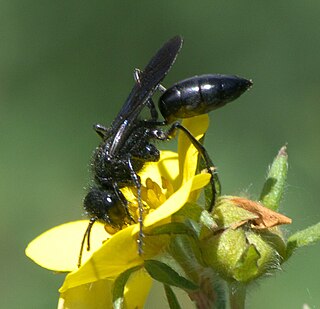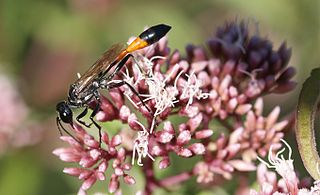
Ammophila is a genus of flowering plants consisting of two or three very similar species of grasses. The common names for these grasses include marram grass, bent grass, and beachgrass. These grasses are found almost exclusively on the first line of coastal sand dunes. Their extensive systems of creeping underground stems or rhizomes allow them to thrive under conditions of shifting sands and high winds, and to help stabilize and prevent coastal erosion. Ammophila species are native to the coasts of the North Atlantic Ocean where they are usually the dominant species on sand dunes. Their native range includes few inland regions, with the Great Lakes of North America being the main exception. The genus name Ammophila originates from the Greek words ἄμμος (ámmos), meaning "sand", and φίλος (philos), meaning "friend".
Ammophila is the Latin name of two genera:

The Sphecidae are a cosmopolitan family of wasps of the suborder Apocrita that includes sand wasps, mud daubers, and other thread-waisted wasps.

Ammophila arenaria is a species of flowering plant in the grass family Poaceae. It is known by the common names marram grass and European beachgrass. It is one of two species of the genus Ammophila. It is native to the coastlines of Europe and North Africa where it grows in the sands of beach dunes. It is a perennial grass forming stiff, hardy clumps of erect stems up to 1.2 metres (3.9 ft) in height. It grows from a network of thick rhizomes which give it a sturdy anchor in its sand substrate and allow it to spread upward as sand accumulates. These rhizomes can grow laterally by 2 metres (7 feet) in six months. One clump can produce 100 new shoots annually.

Ammophila is the type genus of the subfamily Ammophilinae of the hunting wasp family Sphecidae. Ammophila is a large and cosmopolitan genus, with over 200 species, mostly occurring in the warmer regions of all continents apart from Antarctica.

Ammophila sabulosa, the red-banded sand wasp, is a species of the subfamily Ammophilinae of the hunting wasp family Sphecidae. Found in northern Europe, the wasp is notable for the mass provisioning behaviour of the females, hunting caterpillars mainly on sunny days, paralysing them with a sting, and burying them in a burrow with a single egg. The species is also remarkable for the extent to which females parasitise their own species, either stealing prey from nests of other females to provision their own nests, or in brood parasitism, removing the other female's egg and laying one of her own instead.

Ammophila urnaria is a species of hunting wasp in the family Sphecidae. It is a black and red insect native to the eastern United States. It feeds on nectar but catches and paralyses caterpillars to leave in underground chambers for its developing larvae to consume.

Ammophilinae is a subfamily of thread-waisted wasps in the family Sphecidae. There are about 6 genera and more than 320 described species in Ammophilinae.
Vsevolod Vladimirovich Gussakovskiy was a Russian entomologist who specialised in Hymenoptera. He described many new species.
Ammophila ferruginosa is a species of thread-waisted wasp in the family Sphecidae.

Ammophila pictipennis is a species of thread-waisted wasp in the family Sphecidae, found in the eastern half of North America.
Ammophila placida is a species of thread-waisted wasp in the family Sphecidae.
Ammophila azteca is a species of thread-waisted wasp in the family Sphecidae.
Ammophila femurrubra is a species of thread-waisted wasp in the family Sphecidae.

Ammophila nigricans is a species of thread-waisted wasp in the family Sphecidae.

Ammophila aberti is a species of thread-waisted wasp in the family Sphecidae.
Ammophila wrightii is a species of thread-waisted wasp in the family Sphecidae.
Ammophila aphrodite is a species of thread-waisted wasp in the family Sphecidae.

Ammophila procera, the common thread-waisted wasp, is a species of thread-waisted wasp in the family Sphecidae. It is a common species, found in southern Canada, the United States, and Mexico, and south to Central America.










